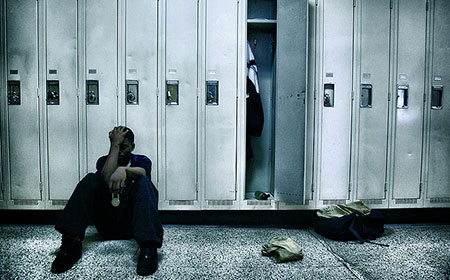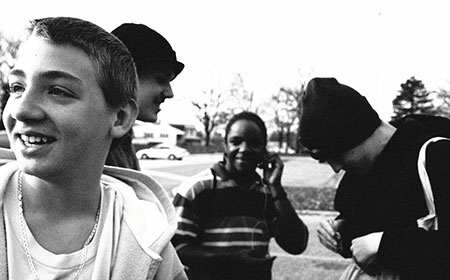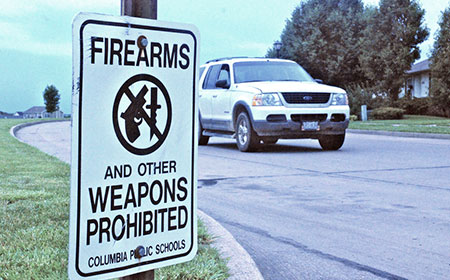9 Signs We Have a “Boy Crisis”
When people speak of a “boy crisis,” they don’t mean the post-punk band from Brooklyn, or the like-totally-awful drama a teenage girl is going through with a kid on the lacrosse team. The term refers to the country’s seeming dilemma of underdevelopment and academic underachievement in young males. Although the issue began to surface as far back as the ’80s, some have held firm in their refusal to acknowledge a reason for concern for our next generation of men. But to us, the tell-tale signs are there to prove American society has a serious problem.
- Boys are twice as likely to be diagnosed for ADHD as girls:
Probably the most commonly cited evidence of a problem among boys is the alarming rate of diagnosis of attention deficit disorder and the corresponding prescription of medications to curb it. According to the CDC, now more than one in nine boys (11.2%) ages 3-17 are diagnosed with ADHD at some point. (The fact that they even diagnose 3-year-olds for short attention spans should be enough to alarm parents and at least give pause to the rest of us.) Over the same age range, only 5.5% of girls will be diagnosed with ADHD, but the rates are trending up for both in recent years.
- Boys are dropping out of school in high numbers:
The high school dropout rate for boys and girls is now one in four, but it’s boys that are keeping that rate high. Black students have suffered from especially low graduation rates, averaging out around 50% but sinking as low as 21% in some communities around the country. Many possible causes exist to explain the problem: a celebration of anti-intellectualism in males in schools, Hollywood, and society in general; boys’ natural aversion to a classroom environment; a failure of teachers to allow “boys to be boys;” even claims that the educational system itself is geared toward helping studious, neat, conforming boys succeed while disenfranchising kids who don’t fit the standard mold. Whatever the reason, something will have to be done to get these guys to graduate.
- Boys’ grades lag behind girls’:
One could make the argument that the education system has actually succeeded when it comes to preparing boys for standardized tests. They routinely record around twice the number of perfect scores on SAT sections, even when more girls take the test. But for some reason, girls consistently earn better grades in their classes, and grades determine high school graduation, advanced class placement, and college admission. Boys take the lion’s share (70%) of D’s and failing grades. Well-known psychologist Michael Thompson recently pointed out that 11th-grade boys now write at the same level as 8th-grade girls. These facts can’t be ignored by simply applauding girls for closing the gap in school; they’re signs that boys are in crisis mode when it comes to grades.
- Boys have suicide rates four times higher than girls:
While the psychology community has been busy promoting awareness of girls’ issues related to body image, “girl power,” and cyberbullying over the last two decades, it appears boys’ mental and emotional health may have been taken for granted. Boys between the ages of 15 and 19 committed suicide at a rate of 12.5 per 100,000 from 1995-2005, as opposed to just 2.8 per 100,000 for girls. Experts like William S. Pollack of the Centers for Men and Young Men at McLean Hospital/Harvard Medical School believe boys’ problems are more hidden and misunderstood, making them arguably more dangerous, and the numbers seem to bear that out. “There’s no doubt that in relation to suicide, boys and young men are in a crisis,” he says. “And almost nothing has been done to remediate it from the gender perspective.”
- The gap between the number of women and men on college campuses is widening:
It may seem like a stretch to link elementary school boys to big men on campus, but the educational groundwork for attending and succeeding in college is laid over those formative years. And somewhere along the way, boys are going astray. One look at a graph of the college enrollment rates for men and women is enough to see that since 1970, women’s numbers have been climbing while men have been sliding lower and lower. Today, women outnumber men on 57% of campuses and enjoy a 3:2 ratio overall. By 2020, men’s enrollment is projected as low as 41.4%, down from 57.7% in 1970. By then, millions more women than men will have earned college degrees.
- Millions of young men are trapped in “Guyland”:
This one is more anecdotal than scientific, but the signs are everywhere that the boy crisis has evolved into a crisis of perpetual boyhood. Many informed observers have begun to shine the light on the legions of 20-something and 30-something men in arrested development between adulthood and immaturity, unable to commit in relationships, confused about manhood, shirking responsibility, and many dependent on parents because of the poor economy. One can’t help but think that this is the fruit being produced by the boy crisis, where boys were denied the opportunity to be boys and thus can’t find their footing to step into manhood.
- Boys are five times more likely to end up in juvenile detention:
Adult men make up about 80% of prison inmates, but boys are incarcerated at an even higher ratio compared to girls at the juvenile level. They are sentenced to juvenile detention facilities five times more than their female counterparts. Considering the history of men and women, we would probably expect males to be involved in crimes more often than women simply because of gender differences, but even recent years of increased arrest rates for girls are not enough to bring them anywhere close to the number of bad boys. According to the Children’s Defense Fund, one out of six Latino boys are at risk for being incarcerated at some point in their lives, and a third of African-American boys.
- Boys are far more likely to be the victims of violent crime:
A fact that goes hand-in-hand with boys’ high rate of incarceration is that they are up to five times more likely to die by homicide (as in 2004) and up to seven times more likely to die in a gun-related death than girls. These are the boys who got out of juvenile detention or managed to never be sent there and who raised their risk factors through certain high-risk behaviors, as laid out by the Department of Health and Human Services. These include early aggressive behavior, drug and/or alcohol abuse, hanging out with other troubled kids, and poor academic performance; in other words, all issues that could be prevented at a young age through education or other responsible adult instruction.
- Schools are taking steps to find solutions:
It’s tough to argue there’s no boy crisis in education when educators are taking major steps to fix it. As one example, schools across the country, from Maine to Florida to Idaho are instituting same-sex classrooms. The idea is to remove the distractions of teasing or flirting with the girls from boys, in order to improve their concentration and hopefully their grades. Some also incorporate features tailored to boys like permission to go for a run before a test and special microphones for teachers to adjust their voices to levels found to be most effective for addressing males. While the programs have detractors (notably, the ACLU), and parents can opt their kids out of the programs if they choose, the classes’ existence proves educators are convinced of the need for a sea of change in the way boys are taught.

 Probably the most commonly cited evidence of a problem among boys is the alarming rate of diagnosis of attention deficit disorder and the corresponding prescription of medications to curb it.
Probably the most commonly cited evidence of a problem among boys is the alarming rate of diagnosis of attention deficit disorder and the corresponding prescription of medications to curb it.  The high school dropout rate for boys and girls is now one in four, but it’s boys that are keeping that rate high.
The high school dropout rate for boys and girls is now one in four, but it’s boys that are keeping that rate high.  One could make the argument that the education system has actually succeeded when it comes to preparing boys for standardized tests. They routinely record around twice the number of
One could make the argument that the education system has actually succeeded when it comes to preparing boys for standardized tests. They routinely record around twice the number of  While the psychology community has been busy promoting awareness of girls’ issues related to body image, “girl power,” and cyberbullying over the last two decades, it appears boys’ mental and emotional health may have been taken for granted. Boys between the ages of 15 and 19 committed suicide at a rate of 12.5 per 100,000 from 1995-2005, as opposed to just 2.8 per 100,000 for girls. Experts like William S. Pollack of the Centers for Men and Young Men at McLean Hospital/Harvard Medical School believe boys’ problems are more hidden and misunderstood, making them arguably more dangerous, and the numbers seem to bear that out. “There’s no doubt that in relation to suicide, boys and young men are in a crisis,” he says. “And almost nothing has been done to remediate it from the gender perspective.”
While the psychology community has been busy promoting awareness of girls’ issues related to body image, “girl power,” and cyberbullying over the last two decades, it appears boys’ mental and emotional health may have been taken for granted. Boys between the ages of 15 and 19 committed suicide at a rate of 12.5 per 100,000 from 1995-2005, as opposed to just 2.8 per 100,000 for girls. Experts like William S. Pollack of the Centers for Men and Young Men at McLean Hospital/Harvard Medical School believe boys’ problems are more hidden and misunderstood, making them arguably more dangerous, and the numbers seem to bear that out. “There’s no doubt that in relation to suicide, boys and young men are in a crisis,” he says. “And almost nothing has been done to remediate it from the gender perspective.” It may seem like a stretch to link elementary school boys to big men on campus, but the educational groundwork for attending and
It may seem like a stretch to link elementary school boys to big men on campus, but the educational groundwork for attending and  This one is more anecdotal than scientific, but the signs are everywhere that the boy crisis has evolved into a crisis of perpetual boyhood. Many informed observers have begun to shine the light on the legions of 20-something and 30-something men in arrested development between adulthood and immaturity, unable to commit in relationships, confused about manhood, shirking responsibility, and many dependent on parents because of the poor economy. One can’t help but think that this is the fruit being produced by the boy crisis, where boys were denied the opportunity to be boys and thus can’t find their footing to step into manhood.
This one is more anecdotal than scientific, but the signs are everywhere that the boy crisis has evolved into a crisis of perpetual boyhood. Many informed observers have begun to shine the light on the legions of 20-something and 30-something men in arrested development between adulthood and immaturity, unable to commit in relationships, confused about manhood, shirking responsibility, and many dependent on parents because of the poor economy. One can’t help but think that this is the fruit being produced by the boy crisis, where boys were denied the opportunity to be boys and thus can’t find their footing to step into manhood. Adult men make up about 80% of prison inmates, but boys are incarcerated at an even higher ratio compared to girls at the juvenile level. They are sentenced to juvenile detention facilities five times more than their female counterparts. Considering the history of men and women, we would probably expect males to be involved in crimes more often than women simply because of gender differences, but even recent years of increased arrest rates for girls are not enough to bring them anywhere close to the number of bad boys. According to the Children’s Defense Fund, one out of six Latino boys are at risk for being incarcerated at some point in their lives, and a third of African-American boys.
Adult men make up about 80% of prison inmates, but boys are incarcerated at an even higher ratio compared to girls at the juvenile level. They are sentenced to juvenile detention facilities five times more than their female counterparts. Considering the history of men and women, we would probably expect males to be involved in crimes more often than women simply because of gender differences, but even recent years of increased arrest rates for girls are not enough to bring them anywhere close to the number of bad boys. According to the Children’s Defense Fund, one out of six Latino boys are at risk for being incarcerated at some point in their lives, and a third of African-American boys. A fact that goes hand-in-hand with boys’ high rate of incarceration is that they are up to five times more likely to die by homicide (as in 2004) and up to seven times more likely to die in a gun-related death than girls. These are the boys who got out of juvenile detention or managed to never be sent there and who raised their risk factors through certain high-risk behaviors, as laid out by the
A fact that goes hand-in-hand with boys’ high rate of incarceration is that they are up to five times more likely to die by homicide (as in 2004) and up to seven times more likely to die in a gun-related death than girls. These are the boys who got out of juvenile detention or managed to never be sent there and who raised their risk factors through certain high-risk behaviors, as laid out by the  It’s tough to argue there’s no boy crisis in education when educators are taking major steps to fix it. As one example, schools across the country, from
It’s tough to argue there’s no boy crisis in education when educators are taking major steps to fix it. As one example, schools across the country, from 





